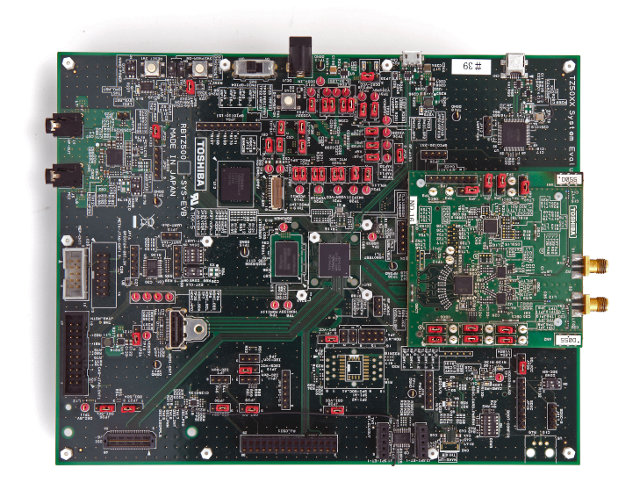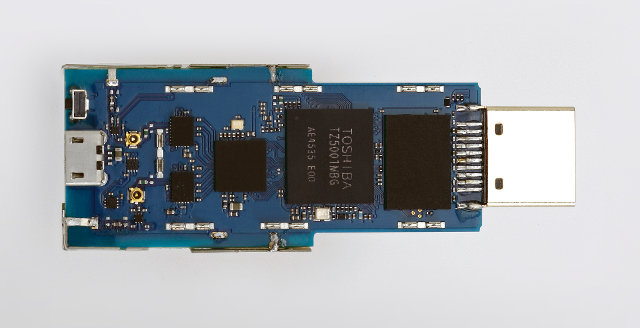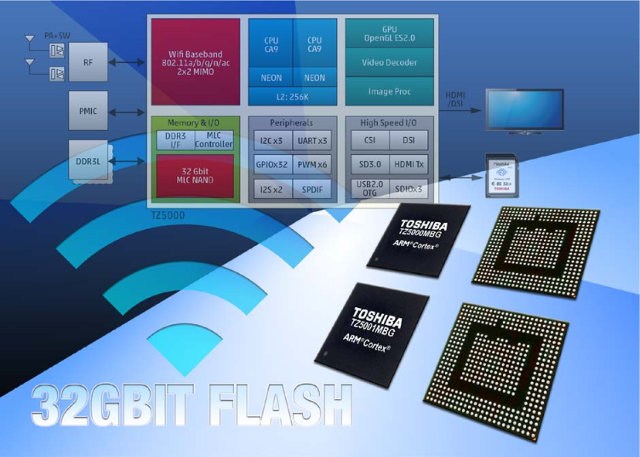Toshiba has recently announced two development kits powered by their TZ5000 ApP Lite SoC featuring two ARM Cortex A9 cores, PowerVR SGX540 GPU, PowerVR VXD395 GPU, an optional 4GB MLC NAND, and Ensigma C4500 Wi-Fi baseband engine into a single chip solution that targets Over-The-Top (OTT) tuners and IP media boxes, wearable devices, digital signage, thin clients, and more. The first development kit, RBTZ5000-6MA-A1, is a full size board that supports Ubuntu, the other one, RBTZ5000-6MA-A1, is an HDMI stick form factor board running Android 4.4.
Toshiba RBTZ5000-2MA-A1 Board (Ubuntu)

RBTZ5000-2MA-A1 Starter Kit specifications:
- SoC – Toshiba TZ5011XBG dual core Cortex A9 processor @ 1.0 GHz with PowerVR VPU and GPU, and Ensigma C4500 Wi-Fi baseband engine
- System Memory – DDR3L-1600
- Storage – 8GB eMMC (external) + MicroSDXC
- Connectivity – Wi-Fi 802.11a/b/g/n/ac 2×2 MIMO (via Ensigma C4500), Bluetooth 4.0. Ethernet is available via a daughter board connected to ADB.
- USB – 2x micro USB 2.0 host ports (via expansion board), and 1x micro USB device port
- Video Output – HDMI 1.4b, MIPI DSI LCD screen connector (via expansion board)
- Camera – MIPI® CSI-2 camera connector
- Audio – I2S, S/PDIF
- Debugging – UART and JTAG
- Expansions – Various headers with peripherals such as cameras or microphones.
- Dimensions – 90mm x 55mm
The Linux SDK includes Ubuntu rootfs, U-Boot, and drivers for Ethernet/Wi-Fi/Bluetooth, USB, UART, GPIO, eMMC/SD/SDIO, I2S, and TIMER/DMA/PWM/PMU.
Toshiba RBTZ5000-6MA-A1 Board (Android)

Starter Kit specifications:
- SoC – Toshiba TZ5001MBG dual core Cortex A9 processor @ 800 MHz with PowerVR VPU and GPU, and Ensigma C4500 Wi-Fi baseband engine, and 4GB on-chip NAND flash.
- System Memory – DDR3L-1600
- Storage – 4GB on-chip NAND flash
- Connectivity – Wi-Fi 802.11a/b/g/n/ac 2×2 MIMO (via Ensigma C4500), Bluetooth 4.0
- USB – 1x micro USB OTG port
- Video Output – HDMI 1.4b
- Debugging – UART and JTAG
- Dimensions – 24mm x 57mm
The board has been mainly developed for transmission of audio, video and other media for streaming delivery. The Android 4.4 SDK also comes with the same driver as for the Linux SDK.
Toshiba TZ5000 ApP Lite SoC

Toshiba is an interesting SoC in that it embeds Wi-Fi and internal Storage, on top of the CPU, GPU and VPU combo usually found in most application processors.
Key features includes:
- Embedded IEEE802.11a/b/g/n/ac 2×2 MIMO Baseband Engine (Ensigma™ C4500)
- Flash Memory – Embedded 32Gbit MLC NAND (Optional, depends on model)
- CPU – Dual-core ARM Cortex-A9 MPCore / NEON @ up to 1.2GHz with 256KB L2 cache
- GPU – PowerVR SGX540
- VPU – PowerVR VXD395
- Graphics/Video Engine – 1080p@60fps Multi Format Decoder, IPC, Scalar, Rotator, Composer
- High-Speed I/O – DDR3/3L/LP-DDR3, USB OTG, SDIO 3.0, HDMI, MIPI CSI and DSI
- Peripherals I/Os – 3x I2C, 32x GPIO, 2x I2S, 3x UART, 6x PWM, SPDIF
Toshiba ZP5000 was first unveiled in February 2014, and TZ5000 ApP Lite starter kit samples will begin shipping in October 2014. Pricing has not been disclosed. Further information can be found on ZP5000 product page. I could not find any pages for the starter kits at this time.
Via LinuxGizmos

Jean-Luc started CNX Software in 2010 as a part-time endeavor, before quitting his job as a software engineering manager, and starting to write daily news, and reviews full time later in 2011.
Support CNX Software! Donate via cryptocurrencies, become a Patron on Patreon, or purchase goods on Amazon or Aliexpress




